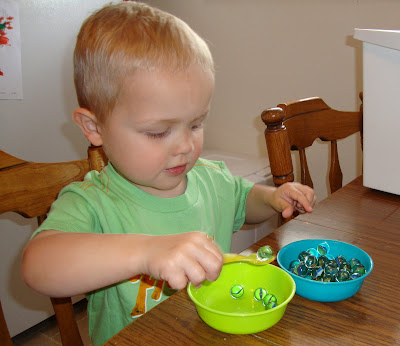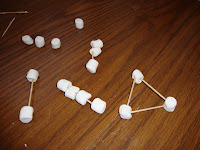This week we've been working with Scientist on his fine motor skills. We've taken ideas for games from different places and also come up with a few on our own. I was a little bit surprised at the positive response I got from Scientist. He loved the games, and would ask to play them over and over. He never suspected we were working on a skill :)

For our first game we used marbles. I filled a small bowl full of marbles and gave Scientist a spoon and told him the game was to pick up the marbles with the spoon and put them in the other bowl. He went back and forth between bowls several times.
Then we decided to take it up a notch. I put the full bowl of marbles on a chair at one end of the kitchen, and the empty bowl on a chair at the other end of the kitchen, so Scientist had to go a lot farther, and do a lot more balancing, to get marbles from one bowl to the other.
After several rounds of that, I tried making a course that was a little bit harder, requiring Scientist to walk a circle around a chair before putting his marble in the bowl, but by that time his attention span was at an end. He did start inventing his own games though, that involved making the marbles make as much noise as possible. :) And that kept him entertained for another 10 minutes or so.

Another game we played this week was to place colored stones in different patterns on a board. For this I just used colored floral stones that I bought at Wal-Mart for $3. For the board I made up my own in Microsoft Word and printed it out. The game was for Scientist to pick out of three different colors, white, light blue, and dark blue, and place the stone on the corresponding color on the board. This game was a little bit more challenging for him. It was interesting for me to see how he chose to meet the requirement. He did all the dark blue stones first, then the all the white, and then the light blue; instead of picking stones at random. After he'd done the whole board a couple times, I turned the board upside for variation.

Scientist's favorite activity was the easiest to come up with and to prepare for. I just gave him an empty cereal box and a pair of safety scissors and let him have at it. He stayed busy for a long time, and this activity is the one he asks to do again most often.


Scientist also really enjoyed our marshmallow game, probably because he got to eat the marshmallows when we were through. For this game we added a little math into the mix. I dumped out a big pile of mini marshmallows and separated them into several different piles with a different number of marshmallows in each pile. I had Scientist count the number of mallows in each pile. Then I gave him a pile of tooth picks and we counted how many of those we had too. Next I let Scientist spear the mallows with the tooth picks, and showed him how to make different shapes by hooking the tooth picks together with marshmallows. We talked about and counted how many sides and how many points each shape had. Before I let him eat the marshmallows, I had him count how many was on each tooth pick as he pulled them off.
A few of the other fine motor activities we did this week were coloring with sidewalk chalk, threading large wooden beads onto a shoelace, and painting both with fingers and with brushes.
Linked up with:













